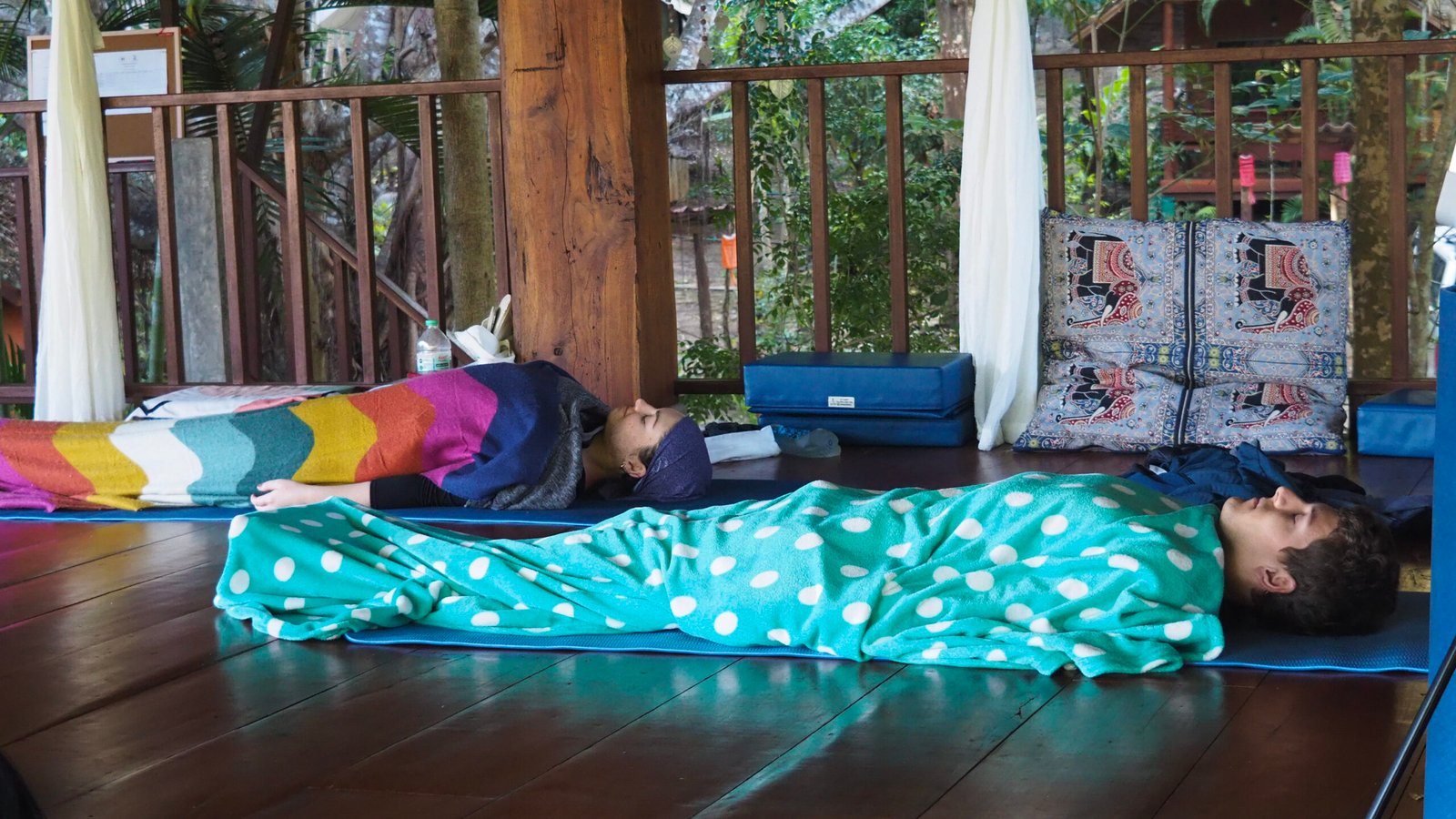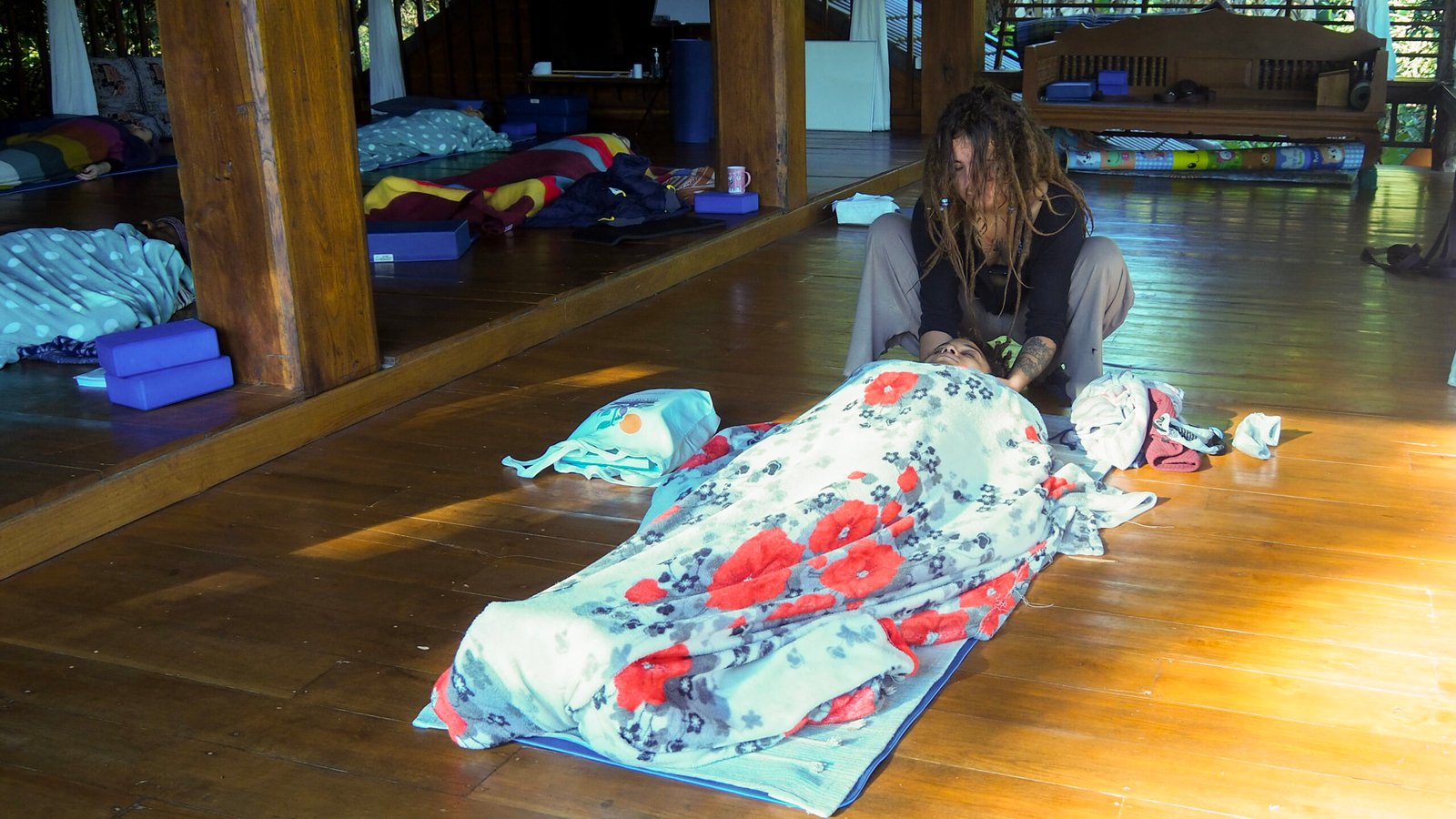
If you are a yoga enthusiast or someone who has been practicing yoga since school, this is for you. You may have come across the terms, Yoga Nidra and meditation, while skimming through yoga texts as well. There are people outside this realm, who are totally confused regarding these two terms. Now, it is not your fault, as these two modalities touch upon one another, have similarities, but are quite different as well. Yoga Nidra to be exact is a guided meditation. As a part of the 200 Hour Yoga Teacher Training In Chiang Mai, you will learn about these forms in details.
Yoga Nidra and Meditation
Let us delve into the details here. Yoga Nidra is a style of relaxing sleep. It is a meditation as well, in which the practitioner floats into a sleep-like condition. You can call it conscious sleep. It is a state in between, where you are neither sleeping fully nor fully awake. You will be taken through guided visualizations, to reach this state. There will be no constraint, when you are in this deep meditative state. The entire practice aims to create a right atmosphere around you, so that you can heal yourself.

At the Yoga School in Chiang Mai, you will experience perfect bliss in this state of mind, just like a feather that has been just shed. Meditation on the other hand, is a broad term. It comprises Yoga Nidra. It is basically a practice, where the individual’s state of mind is on a heightened pedestal. The most popular meditation techniques, which you will come across today are mindfulness meditation, guided meditation, concentrated meditation, and so on. There are various breathing techniques alongside these, that you need to practice to bring about the right effect. After you have completed meditation, and have excelled in disconnecting from all earthly ties, you will be able to sail through, to the ultimate stage called Salvation. It is the pathway, through which you can realize the true nature.
After knowing about these two realms, in detail, you may seem a bit confused. However, there need not be. You will definitely find certain similarities between these two modalities. Both are known to alter the human states of consciousness, through positive affirmations and breathing techniques. The practice leads to alteration of the consciousness. Additionally, they can affect both halves of the brain. You can use these to practice alongside passive yoga poses, to promote stillness around you. So, you can get multiple benefits, while practicing these. Now, let us get to the difference part.
Differences Between Yoga Nidra and Meditation
In the 200 Hour Yoga Teacher Training In Chiang Mai the teachers will explain to you and guide you through both these processes. You should know about them, so as to teach your students the right practice, with proper explanations.
- In most meditation practices, you will be in seated position. The legs will be crossed, and the hands will rest on the knees, with palms facing upwards. You will generally assume the Dhyana mudra, during meditation. Yoga Nidra is practiced, in lying down position. Teachers will be there to guide you through the relaxation process. It is a state, when you will be stopped from falling asleep fully, and also a state where you are not awake in the true sense of the word.
- Meditation is often challenging for beginners, as you have to stop all your thoughts for a while, and look deep within. There will be external noise around you, but you have to stop your mind and senses from absorbing the same. Quietening the chatter around you can be challenging. Yoga Nidra, being a guided practice, you will be taken through the process by the trained experts at Yoga Samaadhi. There are several stages in Yoga Nidra, and you do not have to swim through them alone, and that is one of the biggest differences.
- As a part of the Yoga Nidra class, your teacher will guide you. You will be asked to fix an intention. Once you set that, you will have a goal to follow. After you set up your goal, things become easy. You will be asked to focus your energies at every stage, like focussing on the breath, body sensations, and emotions, and so on. You will soon enter a state, which is dream-like, but not quite one. Additionally, you do not have to make any effort. Meditation is something, that you practice solo. You can gaze at a candle or practice breathing techniques. In the latter, there has to be some effort on your part.
- Yoga meditation is an active process. You have to learn to concentrate all your efforts on a single point. The last state is the receptive one. However, Yoga Nidra is less rigid in nature. You will be using more props and blankets, to ease out the process. You will learn to let go of all your worries, and the mind and the body will both become lighter. You are not striving hard, but you are just floating away, with the universe. The physical body is in a complete state of relaxation. But the mental body will relax and observe the process.
- Yoga Nidra has an ultimate goal, and that is to send the body into a deeply relaxing state. Meditation is on the other hand, a more active process, in which your concentrated efforts will lead to a highly conscious state of mind. It is more spiritual in form.
So, now that you know, about the similarities and differences, it will be better for your learning. You will learn about the same in complete detail in the Yoga School in Chiang Mai. There are ample resources to show you the positives today. You just have to know, how to embrace them. Now, coming to which one you should go for. There is no right or wrong here. It mainly depends on your state of mind and experience. Some practitioners feel that Yoga Nidra comes easier. Moreover, it is a great start for beginners. So, go with the flow.
In today’s world, there are many people across different countries who are looking to improve their sleep quality. Some of these methods might be easier than others, but in this article, the author explains how Yoga can help you go straight to dreamland!
What is a Better Night’s Sleep?
Yoga has been around for centuries and it is said to help with a better night’s sleep. We will explore the science behind why yoga can be beneficial to your sleep and how you can start incorporating it into your routine.
What is Yoga?
Yoga is a centuries-old practice that is based on the idea that through physical activity and meditation, one can achieve deep relaxation and calmness. It is recommended for people of all ages, but is particularly beneficial for those who struggle to get a good night’s sleep.
How does yoga help with a good night’s sleep?
There are many different types of yoga, but the core principle behind all of them is to connect with your body and mind in order to improve your overall well-being. One of the key techniques in yoga for improving sleep is pranayama, which means “breathing control.” Pranayama helps to relax the muscles in your body and clear your mind by slowing down your breathing. When your breathing is slow and deep, it sends oxygenated blood to all parts of your body, including your brain.
How Yoga Relieves Stress
Most people know yoga for its ability to relieve stress, but what many people don’t know is that the practice has science behind it. In fact, there are several studies that show how yoga can improve sleep quality.
One study found that people who practiced yoga regularly reported better sleep quality, including better overall sleep duration and more restful sleep. The study participants also had less daytime fatigue and increased levels of concentration and productivity.
Another study found that regular yoga practitioners had significantly improved sleep quality when compared to those who did not practice yoga. The participants who practiced yoga reported better sleep quality on all seven dimensions of sleep: duration, latency, depth, amount of REM sleep, arousal index, stage 2 Sleep percentage, and stage 3 Sleep percentage.
While these studies are just a small sampling of the many that have been conducted on the subject, they provide evidence that yoga can be an effective way to improve your sleep quality. What’s more, practicing Yoga regularly can help you reduce your overall stress level.
The Science Behind Yoga And Sleep
Many people believe that yoga can help improve your night’s sleep. In fact, there are many scientific studies that back up this claim. One study found that practicing Yoga for just 30 minutes per day could lead to better sleep quality. The reason behind this is that yoga helps to reduce stress and anxiety levels, both of which can affect your sleep. Additionally, yoga can help you improve your breathing habits and concentration. All of these things can lead to a better night’s sleep.
Benefits of Yoga and Better Sleep Quality
A recent study published in the journal “Sleep” has found that yoga can improve sleep quality and quantity. The study, which was conducted on a small sample size of participants, found that those who practiced yoga slept better than those who did not.
The benefits of yoga for improving sleep quality are multi-layered and include reducing stress levels, improving posture and circulation, and increasing mindfulness.
Overall, the findings of this study suggest that yoga could be an effective way to improve sleep quality for some people. However, due to the small sample size, further research is needed to confirm these findings.
Research on the Benefits of Yoga and Sleep
There’s a growing body of scientific evidence that yoga can be beneficial for sleep. In fact, one study found that people who practiced yoga for about an hour before bed reported better sleep quality than those who didn’t. And another study found that people who practiced yoga before bed had lower levels of cortisol, a stress hormone, in their blood the next morning.
So what are the specific benefits of yoga for sleep? Here are five:
1. Yoga helps to improve your breathing techniques. When you breathe correctly, it helps to calm your mind and reduce anxiety. Breathing exercises during yoga also help to promote deep sleep.
2. Yoga helps to improve your posture. Good posture is important for a good night’s sleep because it helps to reduce pain and other symptoms associated with chronic conditions such as back pain or arthritis. In addition, good posture improves blood flow and circulation, which can help improve your sleep quality.
3. Yoga can help reduce stress levels. Stress can disrupt your sleep patterns, leading to restless nights and poor sleep. Yoga can help you to relax, which helps you sleep better.
4. Yoga can increase flexibility and strengthen muscles. The postures involved in yoga require good strength and flexibility of muscles in your back and shoulders. By strengthening these muscles, you can improve your overall health and reduce the risk of injury associated with osteoporosis.
5. Yoga can alleviate pain and discomfort. Mental stress or physical pain that affects sleep is a sign that something needs to be done about it—especially if it impacts daily activities such as work or school.
Yoga Samaadhi Upcoming Events Sustainability Activity | Outreach Program | Yoga Teacher Training (Chiang Mai, Thailand)

Read Our Blog
Read our articles on different topics of yoga, sustainability and community updates…
More Details
Yoga TTC in Thailand
Learn about yoga teacher training and how it guides you to a harmonious lifestyle…
More Details
Community Outreach Programs
Find out more about hill tribes, their ways of life and how we can take part in their progress…
More Details
Sustainability Activity
Find spirituality in sustainability, living in harmony with nature and adopting mindfulness…
More Details